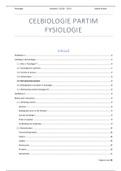Financial Accounting Theory
Inhoudsopgave
Chapter 1 Introduction................................................................................................................................... 4
1.1 THE OBJECTIVE OF THIS BOOK.......................................................................................................................4
1.2 SOME HISTORICAL PERSPECTIVE....................................................................................................................4
1.3 THE 2007 – 2008 MARKET MELTDOWNS.......................................................................................................4
1.4 EFFICIENT CONTRACTING...............................................................................................................................4
1.5 A NOTE ON ETHICAL BEHAVIOUR..................................................................................................................5
1.6 RULE-BASED VERSUS PRINCIPLE-BASED ACCOUNTING STANDARDS.............................................................5
1.7 THE COMPLEXITY OF INFORMATION IN FINANCIAL ACCOUNTING AND REPORTING...................................5
1.8 THE ROLE OF ACCOUNTING RESEARCH..........................................................................................................5
1.9 THE IMPORTANCE OF INFORMATION ASYMMETRY......................................................................................5
1.10 THE FUNDAMENTAL PROBLEM OF FINANCIAL ACCOUNTING THEORY.......................................................6
1.11 REGULATION AS A REACTION TO THE FUNDAMENTAL PROBLEM..............................................................6
Chapter 2 Accounting Under Ideal Conditions................................................................................................. 7
2.1 OVERVIEW......................................................................................................................................................7
2.2 THE PRESENT VALUE MODEL UNDER CERTAINTY..........................................................................................7
2.3 THE PRESENT VALUE MODEL UNDER UNCERTAINTY.....................................................................................7
2.4 EXAMPLES OF PRESENT VALUE ACCOUNTING...............................................................................................8
2.4.1 Embedded Value.....................................................................................................................................8
2.4.2 Reserve Recognition Accounting............................................................................................................8
2.5 HISTORICAL COST ACCOUNTING REVISITED...................................................................................................8
2.6 THE NON-EXISTENCE OF TRUE NET INCOME.................................................................................................8
Opdrachten hoofdstuk 2................................................................................................................................ 9
Chapter 3 The Decision-usefulness Approach to Financial Reporting.............................................................10
3.1 OVERVIEW....................................................................................................................................................10
3.2 THE DECISION-USEFULNESS APPROACH......................................................................................................10
3.3 SINGLE-PERSON DECISION THEORY.............................................................................................................10
3.3.1 Decision Theory Applied.......................................................................................................................10
3.3.2 The Information System.......................................................................................................................11
3.3.3 Information Defined.............................................................................................................................11
3.4 THE RATIONAL, RISK AVERSE INVESTOR......................................................................................................11
3.5 THE PRINCIPLE OF PORTFOLIO DIVERSIFICATION........................................................................................12
3.6 INCREASING THE DECISION-USEFULNESS OF FINANCIAL REPORTING.........................................................12
Chapter 4 Efficient Securities Markets.......................................................................................................... 13
4.1 OVERVIEW....................................................................................................................................................13
, 4.2 EFFICIENT SECURITIES MARKETS..................................................................................................................13
4.3 IMPLICATIONS OF EFFICIENT SECURITIES MARKETS FOR FINANCIAL REPORTING......................................14
4.4 THE INFORMATIVENESS OF PRICE................................................................................................................14
4.5 A MODEL OF COST OF CAPITAL....................................................................................................................14
4.6 INFORMATION ASYMMETRY........................................................................................................................15
Chapter 5 The Value Relevance of Accounting Information...........................................................................16
5.1 OVERVIEW....................................................................................................................................................16
5.2 OUTLINE OF THE RESEARCH PROBLEM........................................................................................................16
5.2.1 Reasons for Market Response..............................................................................................................16
5.2.2 Finding the Market Response...............................................................................................................16
5.2.3 Separating Market-wide and Firm-specific Factors..............................................................................17
5.3 THE BALL AND BROWN STUDY.....................................................................................................................17
5.3.1 Methodology and Findings...................................................................................................................17
5.3.2 Causation Versus Association...............................................................................................................17
5.4 EARNINGS RESPONSE COEFFICIENTS...........................................................................................................18
Chapter 6 The Valuation Approach to Decision Usefulness...........................................................................19
6.1 OVERVIEW....................................................................................................................................................19
6.2 BEHAVIOURAL FINANCE V. MARKET EFFICIENCY AND INVESTOR RATIONALITY.........................................19
6.2.1 Introduction to Behavioural Finance....................................................................................................19
6.2.2 Prospect Theory....................................................................................................................................19
6.2.3 Validity of Beta as the Sole Risk Measure............................................................................................19
6.2.4 Excess Stock Market Volatility..............................................................................................................19
6.3 EFFICIENT SECURITIES MARKET ANOMALIES...............................................................................................20
6.4 LIMITS TO ARBITRAGE..................................................................................................................................20
6.5 A DEFENCE OF AVERAGE INVESTOR RATIONALITY......................................................................................20
6.5.1 Dropping Rational Expectations...........................................................................................................20
6.5.2 Dropping Common Knowledge.............................................................................................................20
6.9 OHLSON’S CLEAN SURPLUS THEORY............................................................................................................20
6.9.1 Three Formulae for Firm Value.............................................................................................................20
Chapter 7 Valuation Applications................................................................................................................. 22
7.1 OVERVIEW....................................................................................................................................................22
7.2 CURRENT VALUE ACCOUNTING...................................................................................................................22
7.4 FINANCIAL INSTRUMENTS DEFINED............................................................................................................22
7.5 PRIMARY FINANCIAL INSTRUMENTS............................................................................................................22
7.6 FAIR VALUE VERSUS HISTORICAL COST........................................................................................................22
7.10 CONCLUSIONS ON ACCOUNTING FOR FINANCIAL INSTRUMENTS............................................................22
7.11 ACCOUNTING FOR INTANGIBLES...............................................................................................................22
7.12 REPORTING ON RISK...................................................................................................................................23
7.12.1 Beta Risk.............................................................................................................................................23
7.12.2 Why Do Investors Care about Firm-specific Risk?..............................................................................23
7.12.3 Stock Market reaction to Other Risks.................................................................................................23
Chapter 8 Efficient Contracting Theory and Accounting.................................................................................24
, 8.1 OVERVIEW....................................................................................................................................................24
8.2 EFFICIENT CONTRACTING THEORY AND ACCOUNTING...............................................................................24
8.3 SOURCES OF EFFICIENT CONTRACTING DEMAND FOR FINANCIAL ACCOUNTING INFORMATION.............24
8.4 ACCOUNTING POLICIES FOR EFFICIENT CONTRACTING...............................................................................24
8.4.1 Reliability..............................................................................................................................................24
8.4.2 Conservatism........................................................................................................................................25
8.5 CONTRACTING RIGIDITY...............................................................................................................................25
Chapter 10 Executive Compensation............................................................................................................ 26
10.1 OVERVIEW..................................................................................................................................................26
10.2 ARE INCENTIVE CONTRACTS NECESSARY?.................................................................................................26
10.3 A MANAGERIAL COMPENSATION PLAN.....................................................................................................26
10.4 THE THEORY OF EXECUTIVE COMPENSATION...........................................................................................26
10.4.2 Short-run Effort and Long-run Effort..................................................................................................26
10.4.3 The Role of Risk in Executive Compensation......................................................................................26
10.7 THE POWER THEORY OF EXECUTIVE COMPENSATION..............................................................................26
Chapter 11 Earnings Management................................................................................................................ 28
11.1 OVERVIEW..................................................................................................................................................28
11.2 PATTERNS OF EARNINGS MANAGEMENT..................................................................................................28
11.3 EVIDENCE OF EARNINGS MANAGEMENT FOR BONUS PURPOSES............................................................29
11.4 OTHER MOTIVATIONS FOR EARNINGS MANAGEMENT.............................................................................29
11.5 THE GOOD SIDE OF EARNINGS MANAGEMENT.........................................................................................29
11.6 THE BAD SIDE OF EARNINGS MANAGEMENT............................................................................................29
11.7 CONCLUSIONS OF EARNINGS MANAGEMENT...........................................................................................29












